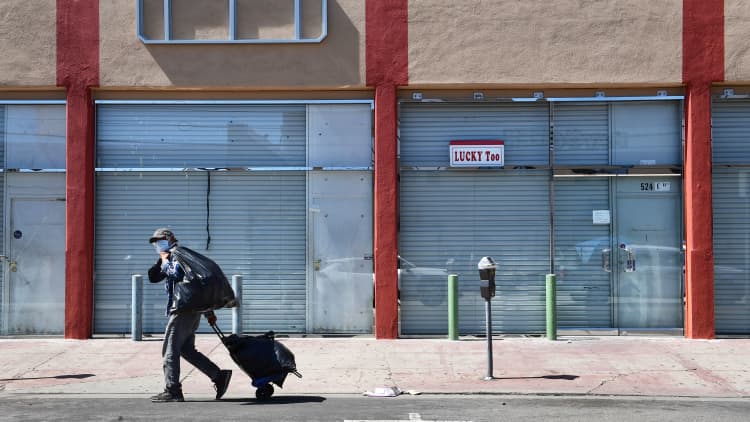Business owners who got a forgivable federal loan may see a difficult choice ahead: getting a loan discharged or allowing workers to collect enhanced unemployment benefits.
But there's a way entrepreneurs can get the best of both worlds: staying debt-free and keeping workers happy.
Specifically, work-sharing programs offer a way for business owners to recall employees to satisfy Paycheck Protection Program rules without jeopardizing expanded unemployment benefits, according to labor experts. Some workers even stand to get higher pay.
"There's a lot of federal money floating around," said Betsey Stevenson, professor of economics and public policy at the University of Michigan. "And a savvy business can make them and their workers better off."
Unemployment benefits, small business loans
The $2.2 trillion coronavirus relief law enacted in March, known as the CARES Act, expanded unemployment benefits for out-of-work Americans and created a forgivable loan program for small businesses.
The funds issued from the Paycheck Protection Program may only be fully forgiven by the federal government if used in a specific way.
For example, the relief law requires business owners to resume paychecks that had been halted for furloughed or laid-off workers. Total loan forgiveness would be reduced if employers cut workers' salaries and wages by more than 25% from pre-pandemic levels. (This applies to those making more than $100,000 annually.)
More from Personal Finance:
This is the average coronavirus stimulus payment in your state
College-bound students to miss out on billions in financial aid
Here are the top 10 cities for summer staycations
Breaching these conditions, among others, would mean a business owner would ultimately need to pay back some of the loan.
However, some business owners have reported tension with the unemployment system.

The CARES Act increased pay for jobless Americans by $600 a week through July 31. Some workers, especially lower-paid ones, can now make more from unemployment benefits than returning to work.
Some entrepreneurs believe this creates a tough choice: Recalling workers from unemployment could foster ill will among workers who may make less money on the job; not doing so may tamper with loan forgiveness.
Work-sharing programs
Work-sharing programs — also known as short-time compensation programs — let entrepreneurs avoid those tradeoffs.
Business owners can hire back workers, thereby keeping loan forgiveness intact, and allow them to continue getting unemployment benefits in addition to their paychecks.
It's a huge wage subsidy.Betsey Stevensonprofessor of economics and public policy at the University of Michigan
The Small Business Administration approved $511 billion in PPP loans to 4.4 million borrowers as of May 23. Nearly 41 million jobless claims have now been filed since the coronavirus was declared a pandemic, according to Labor Department data released Thursday.
A work-sharing program is a layoff-aversion system offered by half of U.S. states. It leverages a state's unemployment insurance system.
Instead of laying off workers to save money, business owners can reduce hours for a group of workers. The work-sharing program continues paying unemployment benefits at a proportionally reduced rate.
For example, a business owner who received a PPP loan and wants full loan forgiveness may opt to rehire workers at 75% of their former hours.
Workers would see a corresponding 75% reduction in their state unemployment benefit — but would keep receiving their $600-a-week unemployment supplement, which is funded by the federal government.
'Huge wage subsidy'
Stevenson, former chief economist at the Labor Department during the Obama administration, offered this example of a full-time worker in Michigan on a 75% work schedule making $20 an hour.
This worker is likely making $962 a week on unemployment (Michigan's maximum weekly $362 payment plus the $600 supplement). That's more than the worker's $800 a week from a typical, 40-hour paycheck.
A short-time compensation program, however, would yield this worker more money than both those scenarios: about $1,291 a week (a $600 paycheck, $600 unemployment supplement, and $91 state unemployment benefit).
And the employee would only be working 75% of their typical work schedule.
"It's a huge wage subsidy," Stevenson said.
These programs offer a way for business owners to give financial incentives to reluctant employees to return to work, she said. Employers must opt into their state program, and states must approve their plans.
Under it, businesses are generally allowed to reduce employee hours by roughly 10% to 60%. And while Michigan is one example of a state permitting businesses to use the Paycheck Protection Program and state work-sharing program in tandem, that might not necessarily be the case for all states, experts said.
The CARES Act also offers a financial incentive for states to establish work-sharing programs: There's 100% federal funding of payments in a state with a short-time compensation program through December, whether that program is new or preexisting.
The Treasury Department deferred a request for comment to the Department of Labor. A DOL spokeswoman didn't confirm whether a business can use PPP loans and work-sharing programs simultaneously in the 25 states that have implemented these programs.
Caveats
There are a few important caveats, according to Ernie Tedeschi, an economist at Evercore ISI.
Work-sharing programs are based on reductions in total hours worked, whereas PPP loan forgiveness concerns a reduction in wages. A business that cut costs by reducing wages as opposed to cutting employees' hours may not be eligible for work-sharing programs, Tedeschi said.
Further, cutting worker hours may make it difficult for some businesses to satisfy another stipulation of PPP loan forgiveness: that a business devote at least 75% of loan funds toward payroll costs.
Reducing worker hours has the effect of reducing overall payroll costs, which may make it more difficult to use three-quarters of the loan toward payroll, Tedeschi said.


